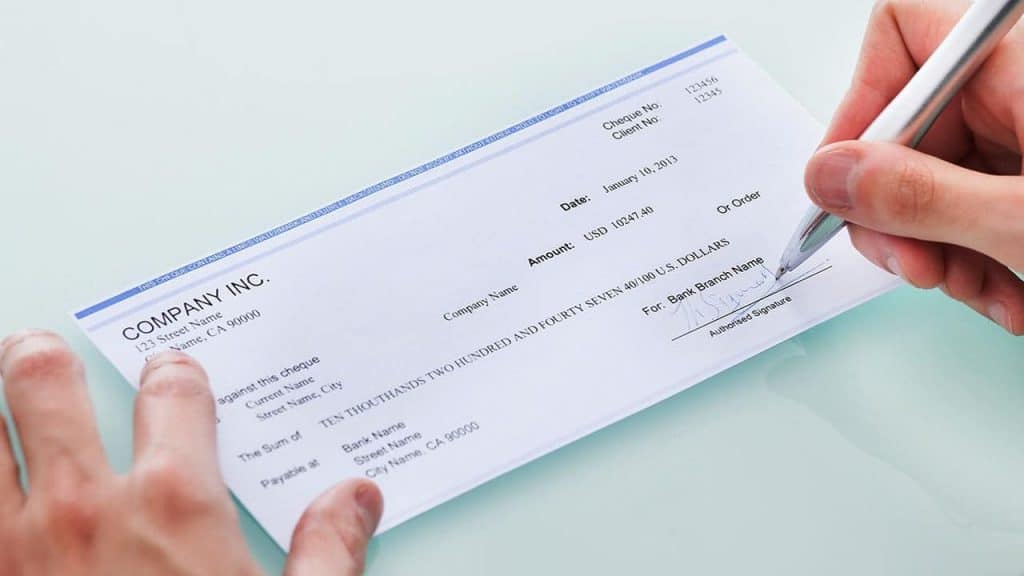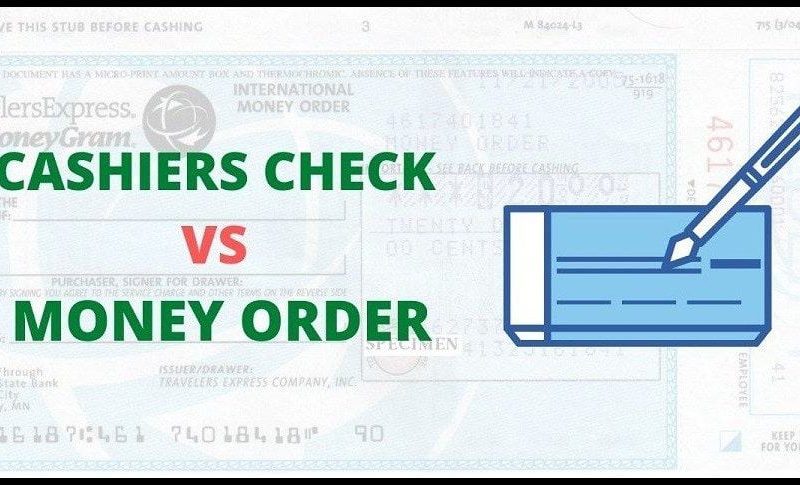Personal checks can bounce, credit card payments can be rejected or challenged, and very few people often choose to carry huge sums of cash around. Cashier’s checks and money orders come in handy in these situations. With cashier’s checks and money orders, funds are available to the payee right away and transactions are guaranteed. On the other hand, personal checks on a standard bank account, take a few days to arrive. However, this article focuses on money orders vs cashier checks. So let’s stay on track…

What is a cashier’s check?
A cashier’s check is a check given by a bank to a third party who pays the bank the face value of the check on behalf of a bank customer. The check is drawn on the bank’s accounts, so the receiver can be confident the funds are secure. Furthermore, for purchases of more than $1,000, a cashier’s check can be used. A cashier’s check cost around $10.
What is a money order?
A money order is a paper document that helps you to safely and inexpensively transfer money to a third party. The issuer is paid the money order’s face value, allowing the payee to be assured that the money order is valid and that he or she will obtain the required amount. Money orders are sometimes used to make smaller payments. But are often capped at $1,000 by several issuers.
If you need a more safe payment form than a personal check or cash — or if you don’t have a checking account — money orders and cashier’s checks can both be useful. They do, however, have some main differences.
Cashier’s Check vs Money Orders
The key distinctions between cashier’s checks and money orders are that cashier’s checks are best for larger transactions and often appear to cost more, while money orders come in smaller quantities but are quicker and simpler to buy.
In other words;
Use a cashier’s check if …
- More than $1,000 was spent on your order.
- You can spend up to $10 on processing checks.
- You have a bank account and financial institution access.
- You’d like a little more protection.
On other hand,
Use a money order if …
- Your purchase costs $1,000 or less
- You can afford to buy a money order for $5 or less.
- You don’t have access to a bank — or it’s more convenient to buy somewhere else.
Either way, here’s how to figure out which one is right for you.
When is it acceptable to use a cashier’s check?
For big orders, cashier’s checks are preferable. Let’s say you want to buy a used car for $5,000, but the seller won’t accept a personal check. You’ll need another type of assured payment if you don’t want to bring large sums of cash.
A cashier’s check, also known as an official check, would be the better option in this situation. Most companies will not issue a money order for more than $1,000, but a cashier’s check usually has no such restriction.
However, if you need to pay a $500 deposit for an apartment and can’t use a personal check, a money order is a better option. They’re usually cheaper.
Cashier’s check vs Money order, Which costs less?
Money orders are often less expensive. Walmart has some of the best money order rates, offering a maximum of 88 cents with valid government-issued photo ID for sums up to $1,000. Depending on the number, the USPS charges ran anywhere from $1.25 to $1.76. Banks also levy a $5 fee.
For Cashier’s checks, fees start from artound US$ 10
However, certain kind of accounts enjoy the privelege of carrying out transaction free of charge. Banks and credit unions cancel fees on cashier’s checks and money orders for these accounts.
Cashier’s Check vs Money Order, Which is the most convenient to purchase?
Money orders are more convenient to obtain. Money orders are available at post offices, several department stores, banks, money transfer outlets, and other locations. Going to the store to get milk? At the customer-service desk, you could also get a money order.
Cashier’s checks, on the other hand, are normally only available from financial institutions to which you belong.
If you want to buy one of them online, you’re out of luck. Furthermore, to purchase a money order or cashier’s check, most issuers require you to go to a physical location. If that isn’t possible, you might ask your recipient to allow you to send money through the internet instead.
Cashier’s Check vs Money Order, Which is safer?
Cashier’s checks are a little more safe. If you misplace or lose a cashier’s check or money order, you will usually get your money back by showing the issuer your receipt and asking for a refund. As a result, neither option is as risky as carrying cash.
A money order, on the other hand, is equivalent to writing a check in that the buyer fills in the recipient’s name. If you misplace the money order before filling it out, it could be cashed by anyone. And you’re unlikely to get your money back once that money order has been cashed.
Cashier’s checks provide a little more security because the financial institution, rather than the buyer, fills out the “pay to” line. A receiver may regard an official check drawn up by a financial institution as more trustworthy than a money order from your local 24-hour market. Either way, this is a good way to ensure payment.
What Is One Benefit of Using a Money Order Instead of a Cashier’s Check?
Money orders are frequently sold in smaller quantities, may be purchased in numerous locations, and only cost a few dollars. Contrarily, cashier’s checks are frequently issued in big amounts, are available from your bank, and are slightly more expensive to obtain.
Is a Cashiers Check or Money Order Cheaper?
Cashier’s checks are more expensive than money orders. Money orders up to $500 cost just $1.45 to mail through the U.S. Postal Service, while money orders between $500.01 and $1,000 cost $1.95. Walmart only levies a $1 maximum fee. It is expected that a cashier’s check will cost at least $5.
What Is the Maximum Amount for a Cashier’s Check?
Online cashier’s checks have a daily limit of $500,000 and a per-check cap of $250,000. Can I cancel a payment after ordering a cashier’s check? When ordering a cashier’s check, the money is taken out of your account right away, making it potentially hard to cancel the payment.
Can a Cashier’s Check Bounce?
Cashier’s checks and cash are NOT the same thing.
The mere fact that the funds seem to be in your account does not guarantee that the check has cleared and is valid. Cashier’s checks that are fake might appear extremely real. Even if the check is a forgery, the bank might still bounce it!






